Alpine A110 R review: more is somehow less for this sublime French coupé

Alpine may be a new name for non-enthusiasts, but it has a terrific pedigree on road, track and rally stage. Formed in 1954, it was the brainchild of Jean Rédélé, amateur racer and son of a Dieppe-based Renault dealer. He named the firm after eponymous mountains and their tortuous roads on which he won a Coupe des Alpes that year in a Renault 4CV he’d tuned himself.
He started out building specials based on that model, then the Dauphine and the R8 saloon that formed the basis of the lithe and lovely A110 two-seat coupé produced from 1963 to 1977. That was the inspiration behind the reimagined A110 launched in 2017, which effectively saved this tiny Renault-owned company.
The 21st century A110 was built of aluminium and therefore light (just over a tonne) and had a relatively simple four-cylinder turbocharged petrol engine with a seven-speed twin-clutch gearbox driving the rear wheels. That weight and size started a virtuous circle of weight saving and better performance and economy, along with fine ride and handling.
In six years, the A110 has garnered lots of friends and spawned several special versions of which this, the A110 R, is the ultimate.
Counting the cost
Last year’s total sales were up 33 per cent to 3,456, though the lion’s share of sales are in France, where the relatively low carbon dioxide emissions of this pretty coupé mean it doesn’t get too blitzed by the stringent “Malus tax” which rises by each gram of CO2 produced, starting at €50 for 123g/km rising to €50,000 above 225g/km. Big and heavy costs plenty in La Belle France.
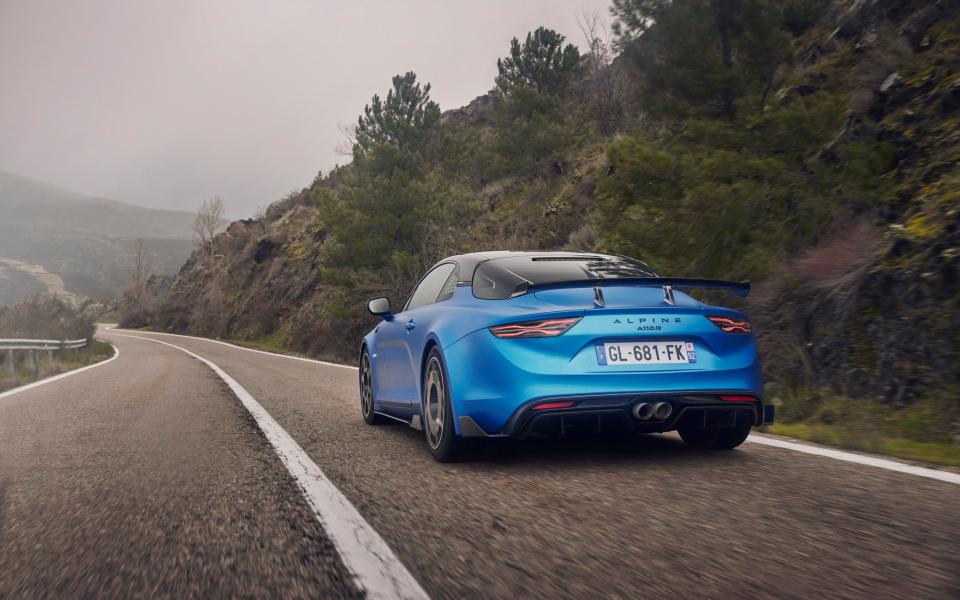
In the UK, where tax is more reasonable (the A110 R’s 154-156g/km will see you paying £585 for the first year’s VED), Alpines remain relatively rare. With last year’s sales of only 288, perhaps the Alpine name isn’t that well known, or perhaps people don’t see the Renault connection as particularly prestigious.
These cars are expensive, too. The standard model costs £51,990, with the more touring-based GT at £61,990, the medium-performance S at £61,990 and now the R at a slightly boggling £89,990. Adding the £6,000 satin blue paintwork, the floor mats, storage net, Focal stereo and red brake calipers gets you as close to £100,000 as makes little difference.
And under the rear bonnet lies exactly the same 296bhp/251lb ft, 1.8-litre four-cylinder engine and seven-speed twin-clutch gearbox as the £62,000 S. The top speed limiter has been taken off so this car will reach a claimed 177mph, with 0-62mph in 3.9sec, and while these cars are individually numbered, this isn’t a limited edition. If you must have a super-exclusive A110, there was a 32-off version of this car called the Fernando Alonso which celebrates the Spaniard’s grand prix wins, but they’re all sold.
So, what’s all the fuss about? You’ll not be surprised to learn it’s more of the same from Alpine; weight-saving through redesign and exotic materials, more downforce through better-channelled air over wings and through vents, and more grip thanks to ZF motorsport coil-over damper units with adjustable spring heights and damper efforts, along with Michelin Cup 2 tyres which are effectively racing tyres for the road.
Just add lightness
Despite the extra componentry, the car is 34kg lighter than the S, which means the 1,082kg A110 R is in some cases 300kg lighter than rivals.
Most significant weight-saving changes are the carbon bucket seats from Sabelt along with carbon-fibre six-point harnesses. There are all-carbon 18-inch wheels, which are made using three construction techniques and glued together – try not to think about it.
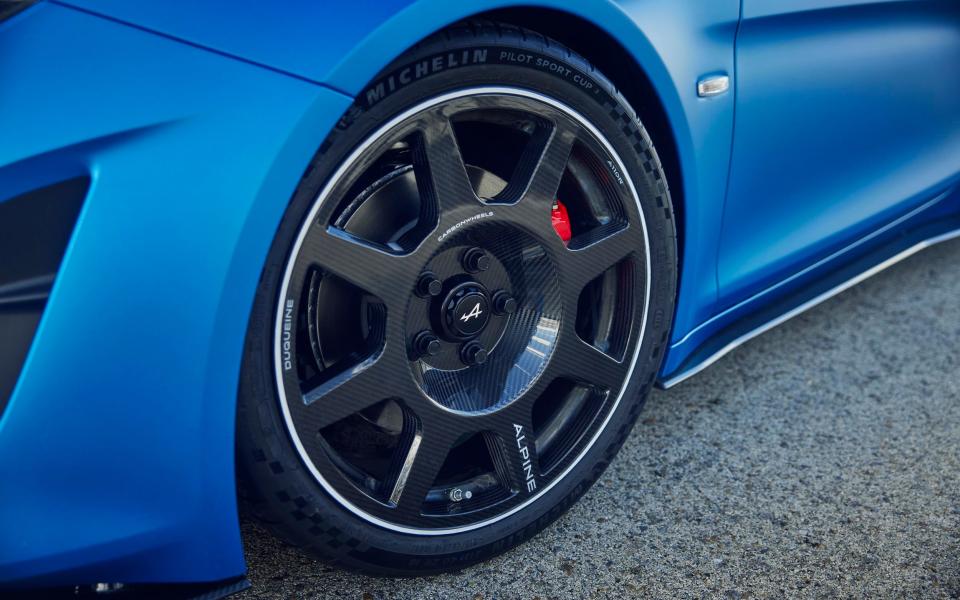
The rear glass has been replaced with an opaque carbon-fibre panel, which means you can’t see out of the rear-view mirror so they’ve binned that, too. The bonnet is now carbon-fibre with wind-cheating nostrils and finished in matt black, which means there’s another 10mph on the top speed in the same way as red brake calipers knock 10 metres off the stopping distance – in your head at least.
The standard car’s engine symposer (which carries engine noise inside) has also been left out and in its place is a simple acoustic pipe from the intake to the interior. The Michelin Cup 2 tyres (215/40/R18 at the front and 245/40/R18 at the rear) fill the arches nicely and the electronic stability program has been recalibrated to match their extra grip.
All-wishbone suspension is lowered by 10mm, with anti-roll bar stiffness up 10 per cent at the front and 25 per cent at the rear. Brembo calipers and steel discs are the same as the optional brakes on the S, but they are surrounded by extra cooling ducts, providing a claimed 20 per cent more brake cooling at top speed.
That rear wing might look a bit radical, but Alpine’s Formula 1 team calculated that such a rearward and elevated position provides more effective downforce at the top speed of 177mph. Carbon-fibre side skirts, diffuser and front spoiler also help to increase rear downforce by 29kg over the S, but it’s down by 30kg at the front to provide a better handling balance.
Circuit star
The A110 R is a revelation on a racing circuit. Most of the time, such antics merely illustrate that road cars are too heavy, with too much power to compensate, and they rely on their tyres and electronics to keep them on the Tarmac.
Not this Alpine, though, which doesn’t seem to stress its tyres one bit as it dashes between apexes and up and down the precipitous inclines of the Jarama circuit. The chassis is more tied down and neutral than in the standard car and the level of grip is quite extraordinary, but while it isn’t a hugely difficult car to drive fast, it is difficult to get it on the limit of adhesion. Its 296bhp engine helps, being sufficient rather than overpowered or dominating the experience.
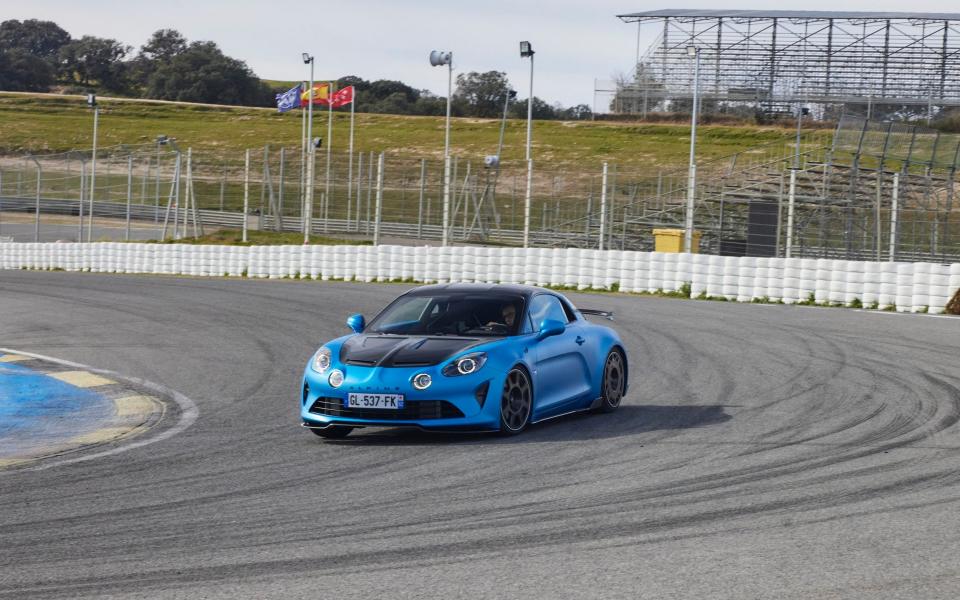
Body roll is reduced compared with the standard A110, but the chassis doesn’t dance quite like the 2017 original, feeling more like a stiff racing car than any version so far. While it’s possible to overestimate its very-capable limits, you’d have to be travelling very fast indeed to do so. Yes, the gap between playing and careening off the circuit is much narrower than in the standard car, but it rewards in other ways such as the astonishing cornering forces available.
And none of this whizzing about seems to damage the tyres in the way it does with heavier cars. That goes for the brakes, too, which are unfadable in four laps of the circuit and haul the R from its top speed time after time without fuss.
Inside job
After a quick lie down, I was escorted out to a row of cars prepared for a two-hour road route around the hills surrounding Madrid. They certainly cut a dash with their contrasting black wings and diffusers and that expensively silky blue paintwork, although there’s an aggression which doesn’t sit well with the subtle charm of the more road-biased A110s.
The interior feels equally exotic, with the Sabelt seats dominating the experience. They hold you like a lover’s embrace but it feels as if you are sitting too high, as indeed you are since while the seats lower the hip point relative to the ground by 5mm the whole car is 10mm lower so in effect you sit 5mm higher. Besides, the standard car’s seats with their gorgeous quilted leather sides are more than supportive enough.
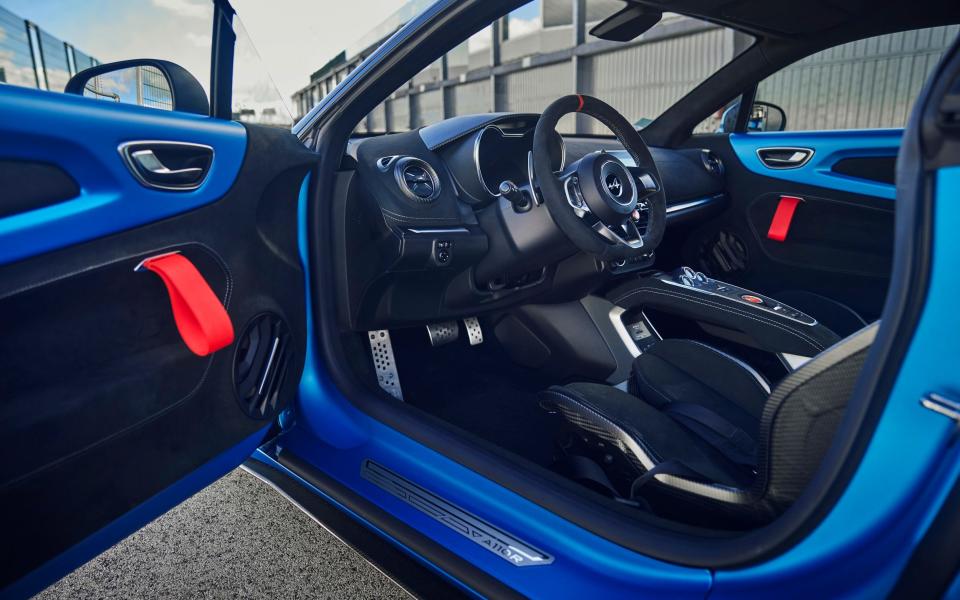
There’s Alcantara everywhere; the steering wheel, dashboard, facia, the door trim panels with contrasting red pulls, but it feels a bit catalogue-racer rather than the classy hides of the standard A110 or the GT version. There’s also a gentleman’s racer feel about it, since the air-conditioning, stereo, touchscreen and so on are the same as all the other models’.
Over tall speed humps you find there’s enough ground clearance to negotiate them straight on, but the tyres and suspension are harsh over small, sharp bumps – and woe betide if you should stick a wheel in a pothole. On UK roads, this is going to be a harsh ride.
And while not having a rear-view mirror is something you eventually get used to, the view to the rear via the door mirrors is very limited to say the least.
On the road
On wider roads at moderate speeds, the suspension still feels quite harsh, throwing you against the racing harness on rippled surfaces. As speed increases, however, the suspension comes into its own with a gentler ride quality but still with humongous grip.
On the right corner you can even turn it in and floor the accelerator, confident that almost whatever happens next will not tax the grip of the Michelins.

Yet while you are travelling quickly, there’s little drama to the experience; the engine still pulls hard from quite low revs and you seldom need to visit the upper limits of the rev counter to make good progress. And, even during circuit use, I averaged 34mpg against an official WLTP figure of 41mpg.
As on the racing circuit, there’s not quite the communicative chassis of the standard car. It provides driving pleasure of a slightly different order, although it’s easy to comprehend why enthusiasts might want to sample this uprated exotic and expensive experience.
The Telegraph verdict
Of course, Alpine could have simply increased the power of the engine, but that would have been to shun the ethos of the A110, which is that light weight, aerodynamics and fine handling are a better engineering solution to going faster.
You will need to know what you are doing and also become accustomed to the limits of this car, but it is a remarkable thing to drive hard on a circuit or briskly on the road. With all its carbon-fibre and go-faster bits, however, it does seem to slightly miss the point of the lovely unadorned standard car, which combines chic looks and charm with undoubted chassis dynamics in a way that no other car maker does (or can).
As to whether the R is any more fun than the S, or even the standard car, to my mind it’s not 100 grand’s worth and even Alpine’s engineers seemed to agree that this car has been built for a very specific sort of customer who places a premium on racing circuit ability.
“If you must,” they winced, agreeing that this wasn’t the point of the A110 programme, and while the A110 R “rounds off the range” it isn’t in their minds the ultimate, just the most radical.
While we still love the A110, it’s not this version that wins us over.
The facts
On test: Alpine A110 R
Body style: two-door coupé
On sale: now
How much? £89,990 (blue paint £6,000 extra)
How fast? 177mph, 0-62mph in 3.9sec
How economical? 40.9-41.5mpg, 34mpg on test
Engine and gearbox: 1,789cc four-cylinder turbocharged petrol, seven-speed twin-clutch gearbox, rear-wheel drive
Maximum power/torque: 296bhp @ 6,300rpm/251lb ft @ 2,400 – 6,000rpm
CO2 emissions: 154-156g/km
VED: £585 first year, £520 next five years, then £165
Warranty: 3 years/60,000 miles
The rivals
Porsche Cayman 718 GT4 RS, £113,700

Stunning 200mph iteration of Stuttgart’s mid-engined coupé. So that’s a 4.0-litre flat six delivering 496bhp and 332lb ft with a red line at 9,000rpm, off-the-hook noise and 0-62mph in 3.4sec. The PDK gearbox does everything for you, which typifies the German approach. It’s good enough to vie with the larger 911 GT3 for thrills, but quite demanding and single-minded.
Lotus Emira, from £71,995
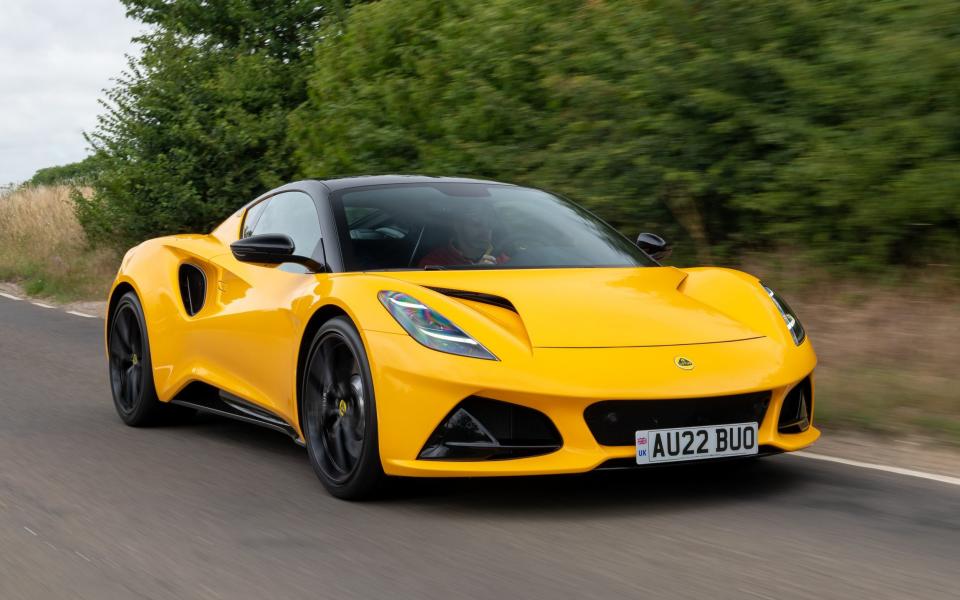
Motoring journalists wealthy enough to afford one are now taking delivery of this, the last solely internal combustion-engined Lotus, but we’re still waiting for a sniff; the Geely-owned Norfolk car maker has been suffering from severe shortages of components, we understand. A 3.5-litre, 400bhp/310lb ft V6 engine providing a top speed of 180mph and 0-60mph in 4.2sec sounds quite respectable. More than that we cannot say.

 Yahoo Movies
Yahoo Movies 